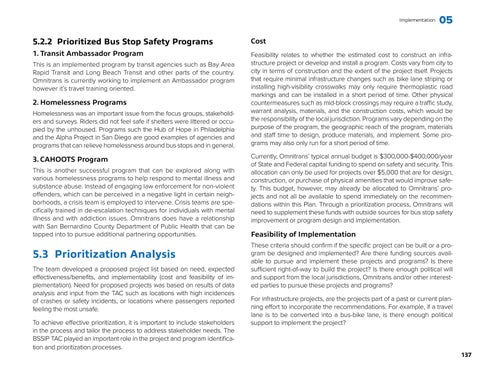Implementation
05
5.2.2 Prioritized Bus Stop Safety Programs
Cost
1. Transit Ambassador Program
Feasibility relates to whether the estimated cost to construct an infrastructure project or develop and install a program. Costs vary from city to city in terms of construction and the extent of the project itself. Projects that require minimal infrastructure changes such as bike lane striping or installing high-visibility crosswalks may only require thermoplastic road markings and can be installed in a short period of time. Other physical countermeasures such as mid-block crossings may require a traffic study, warrant analysis, materials, and the construction costs, which would be the responsibility of the local jurisdiction. Programs vary depending on the purpose of the program, the geographic reach of the program, materials and staff time to design, produce materials, and implement. Some programs may also only run for a short period of time.
This is an implemented program by transit agencies such as Bay Area Rapid Transit and Long Beach Transit and other parts of the country. Omnitrans is currently working to implement an Ambassador program however it’s travel training oriented.
2. Homelessness Programs Homelessness was an important issue from the focus groups, stakeholders and surveys. Riders did not feel safe if shelters were littered or occupied by the unhoused. Programs such the Hub of Hope in Philadelphia and the Alpha Project in San Diego are good examples of agencies and programs that can relieve homelessness around bus stops and in general.
3. CAHOOTS Program This is another successful program that can be explored along with various homelessness programs to help respond to mental illness and substance abuse. Instead of engaging law enforcement for non-violent offenders, which can be perceived in a negative light in certain neighborhoods, a crisis team is employed to intervene. Crisis teams are specifically trained in de-escalation techniques for individuals with mental illness and with addiction issues. Omnitrans does have a relationship with San Bernardino County Department of Public Health that can be tapped into to pursue additional partnering opportunities.
5.3 Prioritization Analysis The team developed a proposed project list based on need, expected effectiveness/benefits, and implementability (cost and feasibility of implementation). Need for proposed projects was based on results of data analysis and input from the TAC such as locations with high incidences of crashes or safety incidents, or locations where passengers reported feeling the most unsafe. To achieve effective prioritization, it is important to include stakeholders in the process and tailor the process to address stakeholder needs. The BSSIP TAC played an important role in the project and program identification and prioritization processes.
Currently, Omnitrans’ typical annual budget is $300,000-$400,000/year of State and Federal capital funding to spend on safety and security. This allocation can only be used for projects over $5,000 that are for design, construction, or purchase of physical amenities that would improve safety. This budget, however, may already be allocated to Omnitrans’ projects and not all be available to spend immediately on the recommendations within this Plan. Through a prioritization process, Omnitrans will need to supplement these funds with outside sources for bus stop safety improvement or program design and implementation.
Feasibility of Implementation These criteria should confirm if the specific project can be built or a program be designed and implemented? Are there funding sources available to pursue and implement these projects and programs? Is there sufficient right-of-way to build the project? Is there enough political will and support from the local jurisdictions, Omnitrans and/or other interested parties to pursue these projects and programs? For infrastructure projects, are the projects part of a past or current planning effort to incorporate the recommendations. For example, if a travel lane is to be converted into a bus-bike lane, is there enough political support to implement the project?
137



















































